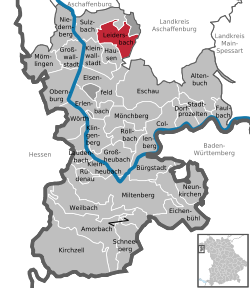Leidersbach | |
|---|---|
Location of Leidersbach within Miltenberg district  | |
| Coordinates: 49°54′N9°13′E / 49.900°N 9.217°E | |
| Country | Germany |
| State | Bavaria |
| Admin. region | Unterfranken |
| District | Miltenberg |
| Subdivisions | 4 Ortsteile |
| Government | |
| • Mayor (2023–29) | Michael Schüßler [1] |
| Area | |
• Total | 19.81 km2 (7.65 sq mi) |
| Elevation | 196 m (643 ft) |
| Population (2023-12-31) [2] | |
• Total | 4,743 |
| • Density | 240/km2 (620/sq mi) |
| Time zone | UTC+01:00 (CET) |
| • Summer (DST) | UTC+02:00 (CEST) |
| Postal codes | 63849 |
| Dialling codes | 06028, 06092 |
| Vehicle registration | MIL |
| Website | www.leidersbach.de |
Leidersbach is a municipality in the Miltenberg district in the Regierungsbezirk of Lower Franconia (Unterfranken) in Bavaria, Germany.



